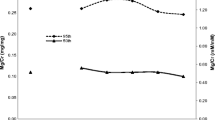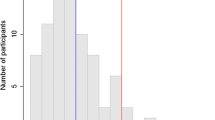Abstract
The aim of this study was to establish age appropriate reference intervals for calcium (Ca), phosphorus (P) and total protein (UTP) in random urine samples. All analytes were measured using the Roche MODULAR P analyzer and normalized to creatinine (Cr). Our study cohort consisted of 674 boys and 728 girls between 7 and 17 years old (y.o.), which allowed us to determine the central 95% reference intervals with 90% confidence intervals by non-parametric analysis partitioned by both gender and 2-year age intervals for each analyte [i.e. boys in age group 7–9 years (7–9 boys); girls in age group 7–9 years (7–9 girls), etc.]. Results for the upper limits of the central 95% reference interval were: for Ca/Cr, 0.27 (16,17 y.o.) to 0.46 mg/mg (7–9 y.o.) for the girls and 0.26 (16,17 y.o.) to 0.43 mg/mg (7–9 y.o.) for the boys; for P/Cr, 0.85 (16,17 y.o.) to 1.44 mg/mg (7–9 y.o.) for the girls and 0.87 (16,17 y.o.) to 1.68 mg/mg (7–9 y.o.) for the boys; for UTP/Cr, 0.30 (7–9 y.o.) to 0.34 mg/mg (10–12 y.o.) for the girls and 0.19 (16,17, y.o.) to 0.26 mg/mg (13–15 y.o.) for the boys. Upper reference limits decreased with increasing age, and age was a statistically significant variable for all analytes. Eight separate age- and gender-specific reference intervals are proposed per analyte.
Similar content being viewed by others
References
Chen Y, Lee AJ, Chen CH, Chesney RW, Stapleton FB, Roy S 3rd (1994) Urinary mineral excretion among normal Taiwanese children. Pediatr Nephrol 8:36–39
Alconcher LF, Castro C, Quintana D, Abt N, Moran L, Gonzalez L, Cella M (1997) Urinary calcium excretion in healthy school children. Pediatr Nephrol 11:186–188
Ceran O, Akin M, Akturk Z, Ozkozaci T (2003) Normal urinary calcium/creatinine ratios in Turkish Children. Indian Pediatr 40:884–887
De Santo NG, Di Iorio B, Capasso G, Paduano C, Stamler R, Langman CB, Stamler J (1992) Population-based data on urinary excretion of calcium, magnesium, oxalate, phosphate and uric acid in children from Cimitile (Southern Italy). Pediatr Nephrol 6:149–157
Esbjorner E (1995) Urinary calcium excretion in Swedish children. Acta Paediatr 84:156–159
Koyun M, Guven AG, Filiz S, Akman S, Akbas H, Baysal YE, Dedeoglu N (2006) Screening for hypercalciuria in schoolchildren: what should be the criteria for diagnosis? Pediatr Nephrol 22:1297–1301
Kruse K, Kracht U, Kruse U (1984) Reference values for urinary calcium excretion and screening for hypercalciuria in children and adolescents. Eur J Pediatr 143:25–31
Manz F, Kehrt R, Lausen B, Merkel A (1999) Urinary calcium excretion in healthy children and adolescents. Pediatr Nephrol 13:894–899
Matos V, van Melle G, Boulat O, Markert M, Bachmann C, Guignard J (1997) Urinary phosphate/creatinine, calcium/creatinine, and magnesium/creatinine ratios in a healthy pediatric population. J Pediatr 131:252–257
Safarinejad MR (2003) Urinary mineral excretion in healthy Iranian children. Pediatr Nephrol 18:140–144
Seifert-McLean CM, Cromer BA, Mosher G, Mahan JD (1989) Urinary calcium excretion in healthy adolescents. J Adolesc Health Care 10:300–304
Sönmez F, Akcanal B, Altincik A, Yenisey C (2007) Urinary calcium excretion in healthy Turkish children. Int Urol Nephrol 39:917–922
Metz M (2006) Determining urinary calcium/creatinine cut-offs for the paediatric population using published data. Ann Clin Biochem 43:398–401
Moxey-Mims MM, Stapleton FB (1993) Hypercalciuria and nephrolcalcinois in children. Curr Opin Pediatr 5:186–190
Pak CY, Kaplan R, Bone H, Townsend J, Waters O (1975) A simple test for the diagnosis of absorptive, resorptive and renal hypercalciurias. N Engl J Med 292:497–500
So NP, Osorio AV, Simon SD, Alon US (2001) Normal urinary calcium/creatinine ratios in African-American and Caucasian children. Pediatr Nephrol 16:133–139
Horn PS, Feng L, Li Y, Pesce AJ (2001) Effect of outliers and nonhealthy individuals on reference interval estimation. Clin Chem 47:2137–2145
Hogg RJ, Portman RJ, Milliner D, Lemley KV, Eddy A, Ingelfinger J (2000) Evaluation and management of proteinuria and nephrotic syndrome in children: recommendations from a pediatric nephrology panel established at the National Kidney Foundation conference on proteinuria, albuminuria, risk, assessment, detection, and elimination (PARADE). Pediatrics 105:1242–1249
Acknowledgments
Support for this study was provided by ARUP Institute for Clinical & Experimental Pathology. We gratefully acknowledge Andrew Wilson for assisting with the statistical analysis.
Author information
Authors and Affiliations
Corresponding author
Rights and permissions
About this article
Cite this article
Slev, P.R., Bunker, A.M., Owen, W.E. et al. Pediatric reference intervals for random urine calcium, phosphorus and total protein. Pediatr Nephrol 25, 1707–1710 (2010). https://doi.org/10.1007/s00467-010-1544-8
Received:
Revised:
Accepted:
Published:
Issue Date:
DOI: https://doi.org/10.1007/s00467-010-1544-8




